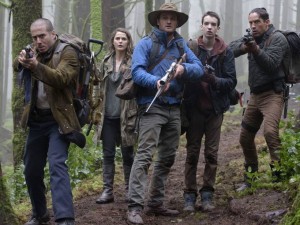The futility of sequels has always been questioned by film geeks because we are cynical that new films might destroy the legacy created by the first. More often than we’d like, we have been proven right. But there also have been instances of sequels being equal to or better than the original films. “Dawn of the Planet of the Apes” is thankfully one such event where we’re proven wrong. It sets a new benchmark for all sequels to come by assaulting us with a arsenal of seamless visual effects, motion capture, story, and screenplay. A word of advice: please watch “Rise of the Planet of the Apes” before you watch this. The parallels drawn from the first film, and the base of “Dawn’s” characters and story, will be easier to interpret.
Caesar and his tribe have lived in the woods establishing a new society of harmony and peaceful co-existence. The Simian Flu, which breaks out at the end of the first film, has now reached a stage where the handful of living humans fear extermination. A bunch of ‘genetically immune’ survivors are left in San Francisco. They try to establish contact to find survivors on other parts of the planet but they cannot, not without power. The dam on the turf of Caesar and his tribe, a hydro-electric plant, holds the answer to the power issue and sparks off the encounters between humans and apes.
You have on screen a film about super-intelligent apes who can talk; a film classified into science fiction. When the same film slyly gets under you skin and makes you think about everything from loyalty to animal cruelty to the disorientation and division of the human society, it is difficult not to hang your jaw in disbelief and awe. The unbearably tense and the profoundly moving narration and depth of “Dawn” is only a preface of the marvelous treats it has in store as the story progresses. The astounding amount of detail that goes into the movement and expressions of the apes fuels your sense of wonder and will not rest until you have surrendered to its crushingly intense authority.
Director Matt Reeves (“Cloverfield“) is in total control from the opening frame itself, letting us sink into the atmosphere after the Flu made it across the planet. The ambitious vision of writers Amanda Silver, Rick Jaffa, and Mark Bomback translates to the screen in an appropriately grand setting with a clarity where you can point out signs that further the story from a desolate street. The film goes on delivering its conceptual surprises, and circumvents predictability at every turn. Without making a single mistake, Reeves and his team plod along steadily to serve up a cinematic wild-ride that is not only nourishing to the intellect but to the heart, too.

Toby Kebbell does a fantastic job at it as Koba, Caesar’s friend and nemesis, and will make you tremble with fear in a few scenes. Gary Oldman (Dreyfus) and Jason Clarke (Malcolm) lead the human side with a group of supporting actors who try their best to do well by the remarkable polish of the story and visual effects. There is a scene where we can see Koba and Caesar drifting apart in their opinions. Caesar wants to allow the humans to continue their ‘work’ and avoid a war, but Koba does not trust them. He points to the scars he received from the Gensys lab experiments and mumbles, “Human work.” Koba gets increasingly agitated by recalling what humans did to him, and it hits your gut with a collapsible feeling of guilt and pity; you understand from that point forth that this is no ordinary film.
“Dawn of the Planet of the Apes” is a sequel that takes the original, pays its homage to it, and stretches it to a scope that is beyond any limitations. It is energetic, perceptive, broad, and incalculably brilliant in its endeavor to tell us the story of Caesar. For he is the Hero of the movie, hallelujah. The word ‘epic’ has been redefined.
What a joy.
– by Yash Bhatia